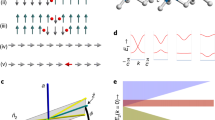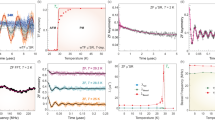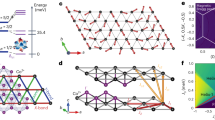Abstract
CoNb2O6 is a material with remarkable properties that are determined by an exciting interplay of quantum mechanics and geometric frustration. On the one hand, weakly coupled ferromagnetic Ising chains of Co2+ ions can be tuned by an applied magnetic field through a quantum critical point to be paramagnetic; on the other hand, the Ising chains must contend with residual interactions on a frustrated triangular lattice in their choice of how to order. Motivated by the material, we theoretically study the phase diagram of quantum ferromagnetic Ising chains coupled antiferromagnetically on a triangular lattice in the plane perpendicular to the chain direction. We combine exact solutions of the quantum criticality in the isolated chains with perturbative approximations for the frustrated interchain couplings. When the triangular lattice has an isosceles distortion, which occurs in the real material, the phase diagram at absolute zero temperature is rich with five different states of matter: ferrimagnetic, Néel, antiferromagnetic, paramagnetic and incommensurate phases, separated by quantum phase transitions. Implications of our results on experiments in CoNb2O6 are discussed.
This is a preview of subscription content, access via your institution
Access options
Subscribe to this journal
Receive 12 print issues and online access
$209.00 per year
only $17.42 per issue
Buy this article
- Purchase on Springer Link
- Instant access to full article PDF
Prices may be subject to local taxes which are calculated during checkout




Similar content being viewed by others
References
Sachdev, S. Quantum Phase Transition (Cambridge Univ. Press, 1999).
Wannier, G. H. Antiferromagnetism. The triangular Ising net. Phys. Rev. 79, 357–364 (1950).
Coldea, R. et al. Quantum criticality in an Ising chain: experimental evidence for emergent E8 symmetry. Science 327, 177–180 (2010).
Lieb, E., Schultz, T. & Mattis, D. Two soluble models of an antiferromagnetic chain. Ann. Phys. 16, 407–466 (1961).
Zamolodchikov, A. B. Integrals of motion and S-matrix of the (scaled) T=Tc Ising model with magnetic field. Int. J. Mod. Phys. A 4, 4235–4248 (1989).
Kobayashi, S., Mitsuda, S., Ishikawa, M., Miyatani, K. & Kohn, K. Three-dimensional magnetic ordering in the quasi-one-dimensional Ising magnet CoNb2O6 with partially released geometrical frustration. Phys. Rev. B 60, 3331–3345 (1999).
Heid, C. et al. Magnetic phase-diagram of CoNb2O6—a neutron-diffraction study. J. Magn. Magn. Mater. 151, 123–131 (1995).
Cao, G., Durairaj, V., Chikara, S., Parkin, S. & Schlottmann, P. Partial antiferromagnetism in spin-chain Sr5Rh4O12, Ca5Ir3O12, and Ca4IrO6 single crystals. Phys. Rev. B 75, 134402 (2007).
Moessner, R., Sondhi, S. L. & Chandra, P. Two-dimensional periodic frustrated Ising models in a transverse field. Phys. Rev. Lett. 84, 4457–4460 (2000).
Pfeuty, P. The one-dimensional Ising model with a transverse field. Ann. Phys. 57, 79–90 (1970).
Fonseca, P. & Zamolodchikov, A. Ising field theory in a magnetic field: Analytic properties of the free energy. J. Stat. Phys. 110, 527–590 (2003).
Scalapino, D. J., Imry, Y. & Pincus, P. Generalized Ginzburg–Landau theory of pseudo-one-dimensional systems. Phys. Rev. B 11, 2042–2048 (1975).
Schulz, H. J. Dynamics of coupled quantum spin chains. Phys. Rev. Lett. 77, 2790–2793 (1996).
Carr, S. T. & Tsvelik, A. M. Spectrum and correlation functions of a quasi-one-dimensional quantum Ising model. Phys. Rev. Lett. 90, 177206 (2003).
Chaikin, P. M. & Lubensky, T. C. Principles of Condensed Matter Physics (Cambridge Univ. Press, 2000).
Acknowledgements
We thank R. Coldea for stimulating discussions and acknowledge support from the Packard Foundation and National Science Foundation through grants DMR-0804564 and PHY05-51164.
Author information
Authors and Affiliations
Contributions
The research reported in the manuscript was carried out by S.B.L. and R.K.K. under the supervision of L.B. The manuscript was written by R.K.K.
Corresponding author
Ethics declarations
Competing interests
The authors declare no competing financial interests.
Supplementary information
Supplementary Information
Supplementary Information (PDF 210 kb)
Rights and permissions
About this article
Cite this article
Lee, S., Kaul, R. & Balents, L. Interplay of quantum criticality and geometric frustration in columbite. Nature Phys 6, 702–706 (2010). https://doi.org/10.1038/nphys1696
Received:
Accepted:
Published:
Issue Date:
DOI: https://doi.org/10.1038/nphys1696
This article is cited by
-
Heat capacity peak at the quantum critical point of the transverse Ising magnet CoNb2O6
Nature Communications (2015)
-
Pulsed-Field Ultrasonic Experiments in the Quasi-2D Antiferromagnet Cs2CuBr4
Journal of Low Temperature Physics (2013)



